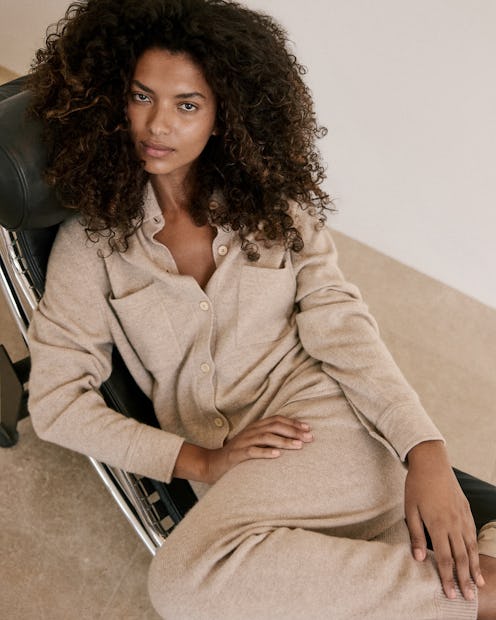(Style)
Everything You Need To Know When Shopping For Cashmere
Straight from the experts.

It’s not uncommon to browse through your favorite store and purchase an under-$150 new-season sweater with little to no thought. But that’s not typically the case with cashmere. Given its steeper price tag, you don’t want to settle on just any style. There are a handful of things to keep at top of mind when splurging on the look, all of which experts broke down for TZR below.
First things first: Why the higher cost? “Cashmere is considered a luxury material, and its higher price compared to other knitwear stems from a combination of rarity, craftsmanship, and quality,” explains Patti Cazzato, the CEO of Naked Cashmere and its new little sister brand, NONAME is needed. “Derived from the fine undercoat of cashmere goats, primarily in Inner Mongolia and parts of India, the material’s scarcity plays a significant role.” What’s more, she says each goat produces only four to six ounces of usable fiber per year, causing cashmere to be an exclusive and sought-after resource.
Price aside, there are myriad benefits of opting for cashmere. For instance, Catherine Morrissey, the founder of White + Warren, points out its classic, always-in-style look. “Most brands are making timeless cashmere styles because they can stand the test of time, and they can really live with you beyond trends or seasons,” she tells TZR. Then there’s the look’s functionality. “Its ability to regulate body temperature enhances wearability, while its natural resistance to odors and pilling adds to its practicality,” says Cazzato.
All this to say? It’s worth adding a cashmere piece to your winter knitwear collection. But before doing so, read up on the must-know expert tips and factors to know when buying the style below.
Pay Attention To Fiber Quality
When picking out a cashmere look, Morrissey suggests paying attention to the fiber quality. “Not all cashmere is created equal,” the expert explains. “There’s Grade A cashmere, which is the top cashmere.” Cazzato echoes Morrissey, explaining that this type is the finest option and offers longer, thinner fibers that create more durable styles. “These pieces retain their shape and softness over time, distinguishing them from lower grades,” the expert adds.
Meanwhile, Cazzato says to opt for 100% cashmere. “Be wary of blends that may include cheaper fibers, as they can compromise the garment’s quality and longevity,” she explains, also noting that the knitting gauge is an important factor. “Higher-gauge knits are tightly woven, denser, and warmer, making them durable and substantial, while lower-gauge knits are lighter and airier but may use less yarn.”
Something else to look out for: Two-ply cashmere. “Two-ply means that the actual yarn is two pieces spun together, which is going to make the yarn itself stronger,” says Morrissey. “You want to see that they’re using a two-ply, which is usually written in copy language.”
If Possible, Touch The Product
Cazzato is a firm believer in touching and seeing the product before making a purchase. “High-quality cashmere should feel luxuriously smooth and soft,” the CEO notes. On the other hand, scratchy or rough textures can mean lower-grade fibers or poor processing, she says. “Details like even, tight knits and well-finished seams can also signal superior craftsmanship, enhancing both durability and style.”
Look For Brands Who Ethically Produce
When you’re deciding on a brand, Cazzato encourages you to choose companies that are transparent about sourcing and ethical practices. “Naked Cashmere, for example, provides full traceability from herd to sweater, not only do we use Grade A fibers from Inner Mongolia, but we visit our herds as often as possible,” the pro explains. In turn, she says this ensures quality, sustainability, and ethical production. “By prioritizing these factors, you can confidently invest in a cashmere piece that combines luxury, comfort, and enduring style.”
What Silhouette To Pick
If you’re only investing in one cashmere piece this season, Morrissey suggests going with a timeless, classic silhouette you’ll turn to year after year. She’d personally choose a pullover — perhaps in a versatile neutral color — or a cardigan. They’re both guaranteed to get plenty of mileage during the chilly months.
How To Care For It After
Given that you’re spending a pretty penny on a cashmere look, it’s wise to properly care for it. Tip: It’s best to hand-wash cashmere with a gentle detergent, according to Morrissey. However, when you hand-wash the piece, she says it’s going to kind of become misshapen. Therefore, Morrissey recommends laying it flat to dry so it goes back into its original shape.
Now that you’ve received a crash course in all things cashmere, shop a selection of the best looks on the market.